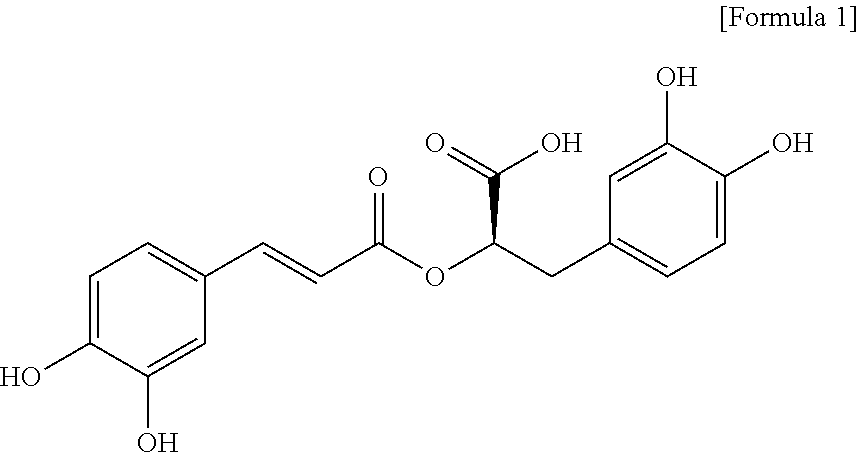Colored food
a technology for food and beverages, applied in the field of colored foods, can solve problems such as dye fading, and achieve the effect of suppressing the fading of dyes and good flavors
- Summary
- Abstract
- Description
- Claims
- Application Information
AI Technical Summary
Benefits of technology
Problems solved by technology
Method used
Image
Examples
examples
(Example 1) Evaluation (1) for the Flavor of Colored Foods Containing Rosemary Immersed Liquor
(Production of Rosemary Immersed Liquor)
[0063]A hundred grams of rosemary leaves (produce of Spain) were immersed in one liter of an aqueous alcohol solution prepared from a commercial product of spirytus vodka 96° by adjusting its alcohol concentration to 59% and the solution was stored at ordinary temperature for 20 days. Thereafter, the supernatant of the aqueous alcohol solution was transferred to another vessel and passed through a filter paper, yielding a filtrate (rosemary immersed liquor A).
[0064](Production of a Colored Food Containing the Rosemary Immersed Liquor)
[0065]A 1-ml portion of the rosemary immersed liquor A was aliquoted and after adding 20 g of commercial sucrose, 1 g of anhydrous citric acid and 50 mg of trisodium citrate, the mixture was thoroughly stirred. Using a solution of edible Red No. 102 and a solution of edible Yellow No. 4, each prepared by dissolving one of...
example 3
(Example 3) Impacts of Alcohol on the Effect of Rosmarinic Acid for Preventing the Fading of Dyes
[0098]The anti-fading effect of rosmarinic acid is known to derive from its activity for preventing oxidation. The oxidation preventing activity of rosmarinic acid was measured by the test for assaying the DPPH radical scavenging activity, which is a common method for measuring the oxidation preventing activity.
[0099]Specifically, a solution having 16 mg of a commercial DPPH reagent dissolved in 100 ml of ethanol, a 0.2 mM MES buffer (pH 6.0) and an aqueous solution of 60% ethanol were mixed in equal volumes and to a 3-ml portion of the resulting solution, 2 ml of a sample of rosmarinic acid in water was added and the mixture was allowed to stand at 25° C. for 30 minutes before absorbance was measured at 520 nm. For comparison, absorbance was measured by replacing the aqueous solution of rosmarinic acid with pure water containing no rosmarinic acid. The concentration of rosmarinic acid a...
PUM
| Property | Measurement | Unit |
|---|---|---|
| vol % | aaaaa | aaaaa |
| vol % | aaaaa | aaaaa |
| time | aaaaa | aaaaa |
Abstract
Description
Claims
Application Information
 Login to View More
Login to View More - R&D
- Intellectual Property
- Life Sciences
- Materials
- Tech Scout
- Unparalleled Data Quality
- Higher Quality Content
- 60% Fewer Hallucinations
Browse by: Latest US Patents, China's latest patents, Technical Efficacy Thesaurus, Application Domain, Technology Topic, Popular Technical Reports.
© 2025 PatSnap. All rights reserved.Legal|Privacy policy|Modern Slavery Act Transparency Statement|Sitemap|About US| Contact US: help@patsnap.com


